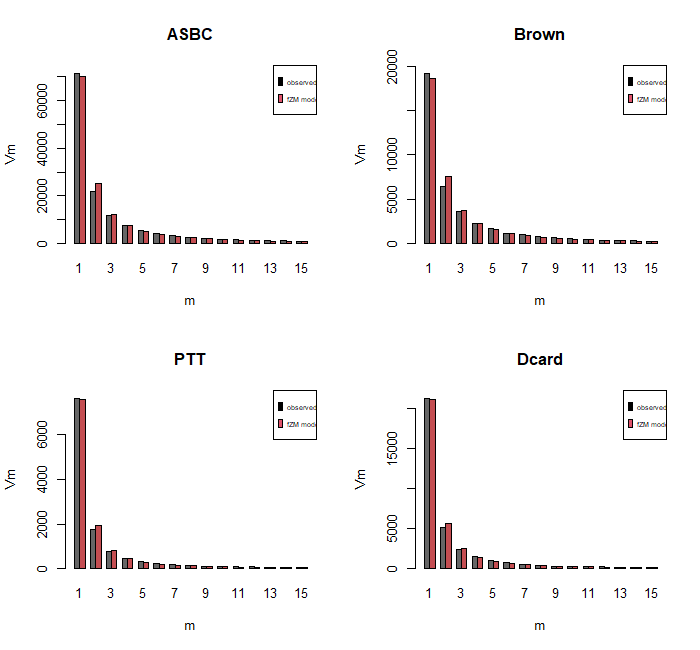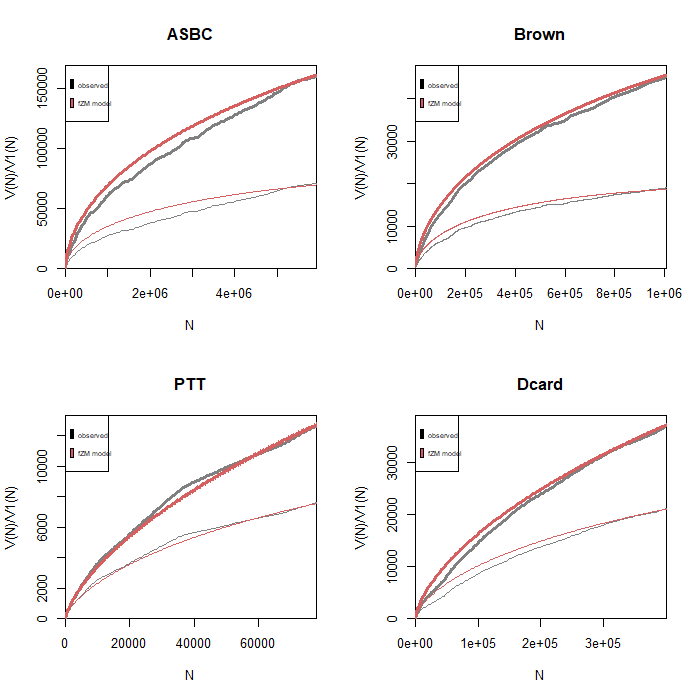這學期修了老闆的課──語料處理方法,認識了一個強大的 R 套件
zipfR The zipfR package for lexical statistics: A tutorial introduction
Introduction 在使用 zipfR 之前,要先認識 Zipf’s law
接下來要了解 token 和 type 的意義。這裡有一個範例詞表:
蘋果, 橘子, 香蕉, 香蕉, 葡萄, 蘋果, 香蕉, 蘋果, 葡萄, 蘋果, 葡萄, 蘋果
這個詞表總共有 12 個 token (sample size = 12),以及 4 個 type
(vocabulary size = 4)。在這裡我們把它表示成
N = 12
V = 4
根據範例詞表,我們可以得到一個 type-frequency list :
接著,我們又可以得到一個 Zipf Ranking ,這裡的 r
將頻率由大到小排序,fr 則是指頻率:
透過 type-frequency
list ,我們可以得到一個計算上非常重要的資料:frequency
spectrum ,其中 m 代表出現次數,Vm 代表出現該次數的單詞共有幾個:
在範例中,出現一次的單詞有一個 (橘子),出現三次的單詞有兩個
(香蕉、葡萄),出現五次的單詞有一個
(蘋果)。只出現過一次的單詞,我們稱之為 hapax legomena 。
2. Lexical Richness 1
2
3
# 載入套件
library ( readr )
library ( zipfR )
首先,將平衡語料庫 (ASBC)、PTT 和 Dcard 語料匯入並整理。PTT 語料來自
2005、2010、2015,以及 2020
共四個年度的八卦板與女板,且對其進行抽樣。
1
2
3
4
5
6
7
8
9
10
11
12
13
14
15
16
17
18
19
20
21
22
23
24
25
26
27
28
29
30
31
#asbc
asbc_corpus <- paste0 ( readLines ( "data\\asbc.txt" , n = 10000 , encoding = 'UTF-8' ), collapse = " " )
asbc_corpus <- unlist ( strsplit ( asbc_corpus , "\\s" ))
# PTT Gossiping board (sampled)
g05 <- sample ( readLines ( "data\\Gossiping_2005_seg.txt" , encoding = "UTF-8" ), 1250 )
g10 <- sample ( readLines ( "data\\Gossiping_2010_seg.txt" , encoding = "UTF-8" ), 1250 )
g15 <- sample ( readLines ( "data\\Gossiping_2015_seg.txt" , encoding = "UTF-8" ), 1250 )
g20 <- sample ( readLines ( "data\\Gossiping_2020_seg.txt" , encoding = "UTF-8" ), 1250 )
g05 <- unlist ( strsplit ( g05 , "\\s" ))
g10 <- unlist ( strsplit ( g10 , "\\s" ))
g15 <- unlist ( strsplit ( g15 , "\\s" ))
g20 <- unlist ( strsplit ( g20 , "\\s" ))
# PTT WomenTalk board (sampled)
w05 <- sample ( readLines ( "data\\WomenTalk_2005_seg.txt" , encoding = "UTF-8" ), 1250 )
w10 <- sample ( readLines ( "data\\WomenTalk_2010_seg.txt" , encoding = "UTF-8" ), 1250 )
w15 <- sample ( readLines ( "data\\WomenTalk_2015_seg.txt" , encoding = "UTF-8" ), 1250 )
w20 <- sample ( readLines ( "data\\WomenTalk_2020_seg.txt" , encoding = "UTF-8" ), 1250 )
w05 <- unlist ( strsplit ( w05 , "\\s" ))
w10 <- unlist ( strsplit ( w10 , "\\s" ))
w15 <- unlist ( strsplit ( w15 , "\\s" ))
w20 <- unlist ( strsplit ( w20 , "\\s" ))
# PTT
ptt_corpus <- c ( g05 , g10 , g15 , g20 , w05 , w10 , w15 , w20 )
# dcard
dcard_corpus <- readLines ( "data\\dcard_corpus.txt" , encoding = "UTF-8" )
Type-frequency List 使用 zipfR 套件,可以簡單地得到 type-frequency list 和它的 Zipf
ranking。為了進行接下來的比較,在這裡將套件內建的 Brown.tfl 一併匯入。
1
2
3
4
asbc.tfl <- vec2tfl ( asbc_corpus )
data ( "Brown.tfl" )
ptt.tfl <- vec2tfl ( ptt_corpus )
dcard.tfl <- vec2tfl ( dcard_corpus )
看一下資料的樣子。其中 k 代表 Zipf’s ranking,f 代表頻率,N 是
sample size,V 是 type count:
1
2
3
4
5
6
7
8
9
10
11
12
head ( ptt.tfl )
## k f type
## 的 1 3039 的
## 是 2 1578 是
## 我 3 1506 我
## 不 4 1123 不
## 了 5 1070 了
## 有 6 846 有
##
## N V
## 77826 12837
zipfR 也可以讓我們輕鬆將資料視覺化:
1
2
3
4
5
6
7
8
9
par ( mfrow = c ( 2 , 2 )) # 2*2 plot area
plot ( asbc.tfl , main = "ASBC" , log = "xy" , # logarithmic scale
xlab = "rank" , ylab = "frequency" )
plot ( Brown.tfl , main = "Brown" , log = "xy" ,
xlab = "rank" , ylab = "frequency" )
plot ( ptt.tfl , main = "PTT" , log = "xy" ,
xlab = "rank" , ylab = "frequency" )
plot ( dcard.tfl , main = "Dcard" , log = "xy" ,
xlab = "rank" , ylab = "frequency" )
Frequency Spectrum 透過剛剛的 type-frequency list,我們可以得到 frequency spectrum。Brown
corpus 的 frequency spectrum 可直接從套件中匯入:
1
2
3
4
asbc.spc <- tfl2spc ( asbc.tfl )
data ( "Brown.spc" )
ptt.spc <- tfl2spc ( ptt.tfl )
dcard.spc <- tfl2spc ( dcard.tfl )
看一下資料的樣子。此處的 m 是指出現次數,Vm 代表出現該次數的 type
共有幾個:
1
2
3
4
5
6
7
8
9
10
11
12
head ( ptt.spc )
## m Vm
## 1 1 7784
## 2 2 1850
## 3 3 777
## 4 4 481
## 5 5 267
## 6 6 209
##
## N V
## 77826 12837
取 log 值後,下圖提供前五十筆 spectrum element 的資料:
1
2
3
4
5
6
7
8
9
par ( mfrow = c ( 2 , 2 ))
plot ( asbc.spc , log = "x" , main = "ASBC" ,
xlab = "m" , ylab = "Vm" )
plot ( Brown.spc , log = "x" , main = "Brown" ,
xlab = "m" , ylab = "Vm" )
plot ( ptt.spc , log = "x" , main = "PTT" ,
xlab = "m" , ylab = "Vm" )
plot ( dcard.spc , log = "x" , main = "Dcard" ,
xlab = "m" , ylab = "Vm" )
從上圖可以得知,hapax legomena (只出現過一次的單詞)
占所有語料庫的比例都相當的高。接下來,我們可以透過 Vocabulary growth
curves (VGC) 來觀察新詞增加的情況。
Vocabulary Growth Curves (VGC) 同樣地,透過 zipfR,我們可以將語料轉成 vgc object。Brown corpus
的資料一樣可以直接匯入:
1
2
3
4
asbc.vgc <- vec2vgc ( asbc_corpus , m.max = 2 )
data ( "Brown.emp.vgc" )
ptt.vgc <- vec2vgc ( ptt_corpus , m.max = 2 )
dcard.vgc <- vec2vgc ( dcard_corpus , m.max = 2 )
來看一下 ptt.vgc 裡面是什麼 :
1
2
3
4
5
6
7
8
9
head ( ptt.vgc )
## N V V1 V2
## 1 1 1 1 0
## 2 392 272 221 30
## 3 783 505 412 49
## 4 1174 711 566 73
## 5 1565 906 723 87
## 6 1956 1080 849 113
以 row 2 為例,表示在前 392 個 token 中,共有 272 個
type,而在其中有 221 個單詞只出現過一次。
將資料畫成圖表:
1
2
3
4
5
6
7
8
9
par ( mfrow = c ( 2 , 2 ))
plot ( asbc.vgc , add.m = 1 , main = "ASBC" ,
xlab = "N" , ylab = "V(N)/V1(N)" )
plot ( Brown.emp.vgc , add.m = 1 , main = "Brown" ,
xlab = "N" , ylab = "V(N)/V1(N)" )
plot ( ptt.vgc , add.m = 1 , main = "PTT" ,
xlab = "N" , ylab = "V(N)/V1(N)" )
plot ( dcard.vgc , add.m = 1 , main = "Dcard" ,
xlab = "N" , ylab = "V(N)/V1(N)" )
上圖中顏色較深的曲線是 V,較淺的曲線是 V1。從圖中可以發現 ASBC 與 Brown
corpus 的 V1 曲線上升後逐漸平緩,然而 PTT 與 Dcard 的 V1
曲線呈現持續上升的趨勢,意指隨著 sample size 增加,hapax legomena
也會不斷增加。這可能是中文斷詞錯誤所造成 (Hsieh
2014)。為了推得母體的真實情況,接下來將使用 Large-Number-of-Rare-Events
(LNRE) models (Baayen 2002)。
Fitting the LNRE Model zipfR 套件中提供了三種 LNRE models,分別是 Generalized Inverse Gauss
Poisson (lnre.gigp; Baayen, 2001, ch. 4)、Zipf-Mandelbrot (lnre.zm;
Evert, 2004),和 finite Zipf-Mandelbrot (lnre.fzm; Evert,
2004),我們首先採用 fzm。
1
2
3
4
5
6
7
8
9
10
11
12
13
14
15
16
asbc.fzm <- lnre ( "fzm" , spc = asbc.spc )
Brown.fzm <- lnre ( "fzm" , spc = Brown.spc )
ptt.fzm <- lnre ( "fzm" , spc = ptt.spc )
dcard.fzm <- lnre ( "fzm" , spc = dcard.spc )
# frequency spectrum
asbc.fzm.spc <- lnre.spc ( asbc.fzm , N ( asbc.spc ))
Brown.fzm.spc <- lnre.spc ( Brown.fzm , N ( Brown.spc ))
ptt.fzm.spc <- lnre.spc ( ptt.fzm , N ( ptt.spc ))
dcard.fzm.spc <- lnre.spc ( dcard.fzm , N ( dcard.spc ))
# VGC
asbc.fzm.vgc <- lnre.vgc ( asbc.fzm , N ( asbc.vgc ), m.max = 1 , variances = TRUE )
Brown.fzm.vgc <- lnre.vgc ( Brown.fzm , N ( Brown.emp.vgc ), m.max = 1 , variances = TRUE )
ptt.fzm.vgc <- lnre.vgc ( ptt.fzm , N ( ptt.vgc ), m.max = 1 , variances = TRUE )
dcard.fzm.vgc <- lnre.vgc ( dcard.fzm , N ( dcard.vgc ), m.max = 1 , variances = TRUE )
Observed and expected frequency spectra:
1
2
3
4
5
6
7
8
9
10
11
12
13
14
15
16
17
par ( mfrow = c ( 2 , 2 ))
plot ( asbc.spc , asbc.fzm.spc ,
main = "ASBC" , xlab = "m" , ylab = "Vm" )
legend ( "topright" , legend = c ( "observed" , "fZM model" ),
fill = 1 : 2 , cex = 0.5 )
plot ( Brown.spc , Brown.fzm.spc ,
main = "Brown" , xlab = "m" , ylab = "Vm" )
legend ( "topright" , legend = c ( "observed" , "fZM model" ),
fill = 1 : 2 , cex = 0.5 )
plot ( ptt.spc , ptt.fzm.spc ,
main = "PTT" , xlab = "m" , ylab = "Vm" )
legend ( "topright" , legend = c ( "observed" , "fZM model" ),
fill = 1 : 2 , cex = 0.5 )
plot ( dcard.spc , dcard.fzm.spc ,
main = "Dcard" , xlab = "m" , ylab = "Vm" )
legend ( "topright" , legend = c ( "observed" , "fZM model" ),
fill = 1 : 2 , cex = 0.5 )
Observed and expected VGC:
1
2
3
4
5
6
7
8
9
10
11
12
13
14
15
16
17
par ( mfrow = c ( 2 , 2 ))
plot ( asbc.vgc , asbc.fzm.vgc , add.m = 1 ,
main = "ASBC" , xlab = "N" , ylab = "V(N)/V1(N)" )
legend ( "topleft" , legend = c ( "observed" , "fZM model" ),
fill = 1 : 2 , cex = 0.5 )
plot ( Brown.emp.vgc , Brown.fzm.vgc , add.m = 1 ,
main = "Brown" , xlab = "N" , ylab = "V(N)/V1(N)" )
legend ( "topleft" , legend = c ( "observed" , "fZM model" ),
fill = 1 : 2 , cex = 0.5 )
plot ( ptt.vgc , ptt.fzm.vgc , add.m = 1 ,
main = "PTT" , xlab = "N" , ylab = "V(N)/V1(N)" )
legend ( "topleft" , legend = c ( "observed" , "fZM model" ),
fill = 1 : 2 , cex = 0.5 )
plot ( dcard.vgc , dcard.fzm.vgc , add.m = 1 ,
main = "Dcard" , xlab = "N" , ylab = "V(N)/V1(N)" )
legend ( "topleft" , legend = c ( "observed" , "fZM model" ),
fill = 1 : 2 , cex = 0.5 )
上方的紅色曲線代表透過 fZM model 所產生的 expected value。
Lexical Coverage Estimation Out-Of-Vocabulary (OOV) types 我們可以藉由 Out-Of-Vocabulary (OOV) types 的比例來了解兩個 corpus
的 lexical
coverage。基本上,一個實用的語言資源中,OOV
所佔的比例應保持在一定標準之下。
我們先採前十萬個 lemma:
1
2
3
4
asbc100k <- head ( asbc_corpus , 100000 )
data ( "Brown100k.spc" )
ptt100k <- head ( ptt_corpus , 100000 )
dcard100k <- head ( dcard_corpus , 100000 )
同樣地,將他們轉成 spc object:
1
2
3
4
5
6
7
asbc100k.tfl <- vec2tfl ( asbc100k )
ptt100k.tfl <- vec2tfl ( ptt100k )
dcard100k.tfl <- vec2tfl ( dcard100k )
asbc100k.spc <- tfl2spc ( asbc100k.tfl )
ptt100k.spc <- tfl2spc ( ptt100k.tfl )
dcard100k.spc <- tfl2spc ( dcard100k.tfl )
首先,我們要計算 lexical of seen
types。在這裡,我們將只出現過一次 的 type 都算成 OOV。也就是說,我們想要知道語料中至少出現過兩次 的 type 總共有幾個:
1
2
3
4
asbc_Vseen <- V ( asbc100k.spc ) - Vm ( asbc100k.spc , 1 )
Brown_Vseen <- V ( Brown100k.spc ) - Vm ( Brown100k.spc , 1 )
ptt_Vseen <- V ( ptt100k.spc ) - Vm ( ptt100k.spc , 1 )
dcard_Vseen <- V ( dcard100k.spc ) - Vm ( dcard100k.spc , 1 )
Fitting the LNRE Model 1
2
3
4
asbc100k.fzm <- lnre ( "fzm" , asbc100k.spc )
Brown100k.fzm <- lnre ( "fzm" , Brown100k.spc )
ptt100k.fzm <- lnre ( "fzm" , ptt100k.spc )
dcard100k.fzm <- lnre ( "fzm" , dcard100k.spc )
以 Brown corpus 為例,假設我們用 1, 10, or 100 million tokens
進行計算,expected OOV 分別會是:
1
2
3
4
5
6
7
8
9
10
11
12
13
14
15
16
17
18
19
# ASBC
1 - ( asbc_Vseen / EV ( asbc100k.fzm , c ( 1e6 , 10e6 , 100e6 )))
## [1] 0.7751460 0.7844322 0.7844322
# Brown
1 - ( Brown_Vseen / EV ( Brown100k.fzm , c ( 1e6 , 10e6 , 100e6 )))
## [1] 0.7299293 0.7347804 0.7347804
# PTT
1 - ( ptt_Vseen / EV ( ptt100k.fzm , c ( 1e6 , 10e6 , 100e6 )))
## [1] 0.8847203 0.9098196 0.9098338
# Dcard
1 - ( dcard_Vseen / EV ( dcard100k.fzm , c ( 1e6 , 10e6 , 100e6 )))
## [1] 0.8608032 0.8905452 0.8905602
從上方得到的數值可以發現,ASBC 和 Brown corpus 的 OOV ratio 較 PTT 和
Dcard 來得穩定且比例也較低。
結論 利用 zipfR 並採用 LNRE model 對資料進行分析,取得語料的 VGC 和
OOV ratio,就可以分析平衡語料庫、Brown corpus、PTT 和 Dcard 的 lexical
richness 和 lexical coverage。目前的發現是:
不同於 ASBC 和 Brown Corpus 最後達成平緩的趨勢,PTT 與 Dcard 的
VGC V1 曲線都隨著 sample size 的增加持續上升。
從 expected OOV ratio 來看,PTT 與 Dcard 語料的 OOV
除比例較高外,也隨著 corpus size 的增加而持續上升,並不如 ASBC 與
Brown corpus 穩定。
可能的原因是,ASBC 是機器斷詞後再進行人工校正而成的語料庫,而 Brown
Corpus
是英文語料,字詞與字詞之間已有空白分隔,所以這兩個語料庫較無斷詞錯誤導致新詞不斷增加的問題。然而現今的
Web-as-Corpus,其前處理通常採用機器自動斷詞,龐大的 OOV
可能來自於斷詞錯誤。這說明了在建造中文 Web-as-Corpus
時,斷詞問題是很重要的考量之一。
References Baayen, R. H. (2002). Word frequency distributions (Vol. 18). Springer Science & Business Media.
Evert S, Baroni M (2007). “zipfR : Word Frequency Distributions in R.” In Proceedings of the 45th Annual Meeting of the Association for Computational Linguistics, Posters and Demonstrations Sessions , 29–32. (R package version 0.6-70 of 2020-10-10).
Kilgarriff, A., & Grefenstette, G. (2003). Introduction to the special issue on the web as corpus. Computational linguistics , 29(3), 333-347.
Hsieh, S.-K. (2014, may). Why Chinese Web-as-Corpus is Wacky? Or: How Big Data is Killing Chinese Corpus Linguistics . Paper presented at the Proceedings of the Ninth International Conference on Language Resources and Evaluation (LREC?14), Reykjavik, Iceland.
Special Thanks 謝謝 Jessy 和 Yongfu 在 HOCOR 2020
Click here posterdown





